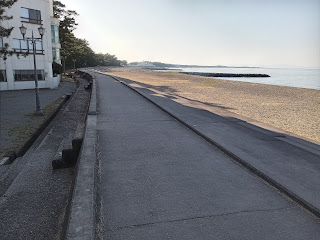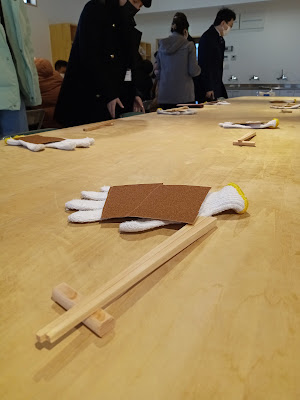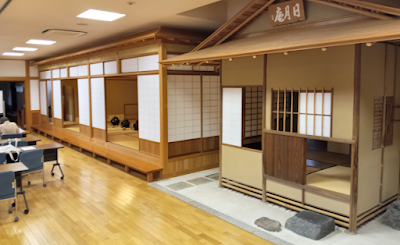 |
| Futami-ura near the Meoto-iwa and shrine of Futami |
During the morning lectures we found out about the Ise Jingu pilgrims by boat and the sea communication with Edo in the feudal decades, as well as the local salt-makers recorded in history for the coastal areas between Ise and the Bay of Ise: Ominato, Kami-yashiro, and Futami. Then came the 1498 earthquake and tsunami which remains in the records of the time as catastrophic, not least for altering the river course of the Isuzu, destroying people and economies of the coastal zone for the next 100 years, and setting the stage for ship building to begin. Next we gained a preview of the places to see two days from now in the mountains of the Kumano Kodo and its three major shrines (San Zan). After lunch we went to see where the Ise Jingu salt for daily kami offerings of food comes from. It is also used for purifying and banishing filth.
 |
| Isuzu estuary > Mishio-hama > Mishioden shrine 御塩殿神社 (concentrated brine storage) |
Our bus crossed the Isuzu river where the incoming tide brings saltwater to let into the evaporation yard (center photo) to bring the mix from 3% (seawater) to 20% (brine for boiling). The salt production is fixed to calendar dates in late July and supplies the Outer and Inner Shrines of the Jingu in Ise. We learned that it has been going on this way since Heian times and probably earlier, too. Because of the system of repeating the rituals and structures generation after generation, there is a good chance that similar salt making for the Jingu will still be in operation after 1,000 more years, too.
 |
| Hinjitsukan (a.k.a. Futamikan) at left, one of many frogs around the Me-oto Iwa (right) |
Pilgrims by boat who landed at Futami or near O-minato sometimes stayed here (1910s-20s construction) before making the grand tour: Ise Jingu shrines both Inner and Outer, and any others where they wished to pay respects, then a look at the Husband-Wife sea stacks (
Me-oto Iwa) and perhaps to the top of Mt. Asama, as well. By following in the footsteps of people 100 years ago, as well as mingling with 2023 people who pay their respects at the Jingu and other shrines, we get a close-up look at the living tradition connected to Ise as it fits into the lives of people now.
March 3 is the customary day for celebrating the (heirloom) doll collection in many families,
Hina Matsuri, or "doll festival." And yet, in the context of the Ise and Japan Study Program with the exploration of Shinto here and more widely in the foreground, to hear the word "matsuri" when it comes to putting Heian era figures on display is confusing. Paying one's respects to the kami fits the verb "matsuru," but celebrating the finery in miniature of court nobles is not part of the sacred communion of person the the larger forces. But then, again, the term "kami" is seen in popular-culture, too; something akin to "guru" - a person who is a few degrees more masterful than one's own abilities; a "go to" source of direction and instruction, for example. However, if just about any situation can be called ___Matsuri and if any advanced or skillful person can be called the Kami-sama of ____, then what does that mean for the shrine and outdoor (non-shrine) experience of kami and paying respects (matsuru).






Comments
Post a Comment